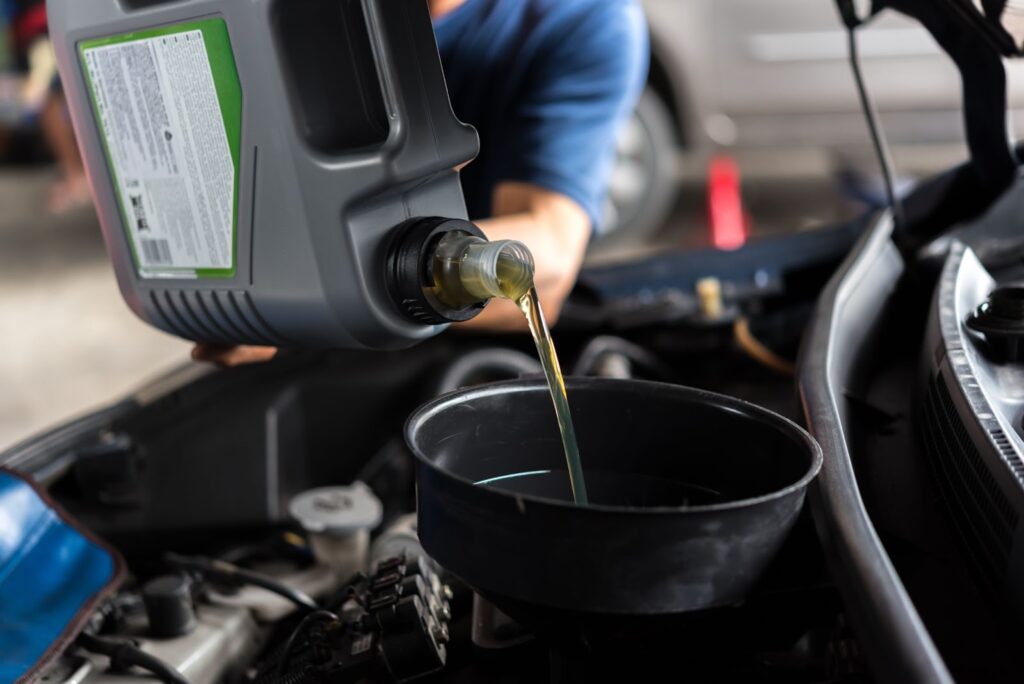Do Cars Need Oil Changes More or Less Often as They Age?

If you own an aging vehicle, you already know how your car’s maintenance needs change over time. To keep your older car on the road, you’ll need to take good care of your engine, brakes, cooling system, and countless other components. But no matter how responsible you are when it comes to maintaining your long-lasting car, you might not fully understand how its oil change schedule needs to be adjusted as it ages.
Whether your car is fresh off the factory line or has been on the road for years, oil changes are a crucial element of auto maintenance. Are you getting full-service oil changes as often as you should? If you aren’t sure, keep reading for advice from the Tate Boys Tire & Service team on scheduling oil changes at every point in your vehicle’s lifespan.
How Aging Affects Your Vehicle’s Oil Change Schedule
The “standard-issue” oil change schedule is easy enough to remember. If you follow this advice, you’ll change your oil every three months or 3,000 miles. This isn’t a bad starting point, but you might need oil changes more (or less) often than this guideline suggests.
All kinds of traits can affect your car’s oil usage, but its age is one of the most critical factors you’ll need to consider when creating an oil change schedule. Generally speaking, older vehicles need oil changes more often than newer cars do. Interestingly enough, this is the case for two reasons:
Newer Engines are More Efficient
Automotive design has changed quite a bit over the past few decades, and these changes have helped improve the performance of newer vehicles compared to their predecessors. As you might expect, modern engines are highly effective when it comes to using oil, allowing drivers to go longer between oil changes as a result.
Older Engines Get Worse at Using Oil
Older vehicles aren’t just at a disadvantage because of the engine designs they use. Years of built-up debris and metal fillings can actively impede your vehicle’s ability to use oil. That means you’ll need to get oil changes more often than you would otherwise.
Other Oil Change Scheduling Factors
Your vehicle’s age is one of the most significant points you’ll need to consider when putting together an oil change schedule. Once you’ve done that, there are a few other things to keep in mind before finalizing this schedule.
- Oil variety. If any factor in oil change scheduling is as vital as your vehicle’s age, it’s your preferred oil variety. For the most part, synthetic oil is more expensive but
 longer lasting. On the other hand, conventional oil is less expensive upfront but will need to be replaced more frequently. (Incidentally, you may want to consider another option if your Oklahoma car has more than 75,000 miles on its odometer—high-mileage motor oil. This is usually a mixture of synthetic and conventional oil specially formulated for the needs of aging engines.)
longer lasting. On the other hand, conventional oil is less expensive upfront but will need to be replaced more frequently. (Incidentally, you may want to consider another option if your Oklahoma car has more than 75,000 miles on its odometer—high-mileage motor oil. This is usually a mixture of synthetic and conventional oil specially formulated for the needs of aging engines.) - Local temperatures. Tulsa may not be the hottest city in America, but this part of the country certainly gets its share of warm weather—especially during the summer months. That heat can change how your vehicle works; as a result, you might need to get oil changes at an increased rate. (For what it’s worth, the same holds if you drive in extreme cold.)
- Driving habits. “Severe” driving is a broader category than you might expect. All kinds of everyday driving habits fit this description, from traveling long distances under 50 miles per hour to driving on dirt roads. Take a close look at how you drive—and if you’re a severe driver, get oil changes at twice the “normal” rate.
Once you’ve considered all of the above factors, you’re ready to build your oil change schedule. To start, use the classic 3,000-mile/three-month schedule as a baseline. Then, adjust it based on your vehicle’s age and the above factors. This process can be surprisingly tricky—if you need help, ask the crew at Tate Boys for advice.
Request An Oil Change Service Quote
Do You Need an Emergency Oil Change?
Even with your carefully crafted oil change schedule, your aging vehicle might need an oil change service sooner than you might expect. But that’s no cause for alarm: if you find yourself in this situation, all you have to do is get an oil change ahead of schedule. If you think you might be overdue for an oil change, check your oil level—if it’s dangerously low, it’s time to get a refill. On top of that, look out for warning signs like:
- Warning lights on your dashboard. There are countless reasons your check engine light can turn on, potentially including oil problems. This light won’t give you more information by itself, so visit Tate Boys when it activates.
- Unexpected engine noises. Dirty motor oil can cause ticking noises when your engine starts up, and thin oil may result in knocking engine sounds.
- Exhaust smoke. If you’re using aged motor oil, it could cause smoke to come from your vehicle’s exhaust pipe.
- Strange vibrations. Dirty oil could be the cause of unusual vibrating sensations in your vehicle. If you think your car might have this issue, pay attention while your car is idling—it’s especially easy to notice this symptom while it does.
How to Take Care of Older Vehicles
If you drive an aging car, creating an oil change schedule that takes your vehicle’s needs into account is a great first step. But even though regular oil changes are a crucial part of auto maintenance, this service can’t keep your vehicle in good shape in isolation. Once you’ve put together a workable oil change schedule, shift gears and focus on caring for the following components of your vehicle:
Brakes
Getting new brake pads is a handy way to extend the life of your brakes, but your brake maintenance efforts shouldn’t stop there. Make a point of replacing your brake fluid as scheduled (in most cases, once every two years). Also, be careful about how you brake—that is to say, avoid slamming your brakes whenever possible. Instead, gradually ease to a stop to put minimal strain on this system.
Cooling System
Your cooling system has a demanding job—it’s responsible for controlling your engine temperature and transporting highly-pressurized fluids at temperatures over 200 degrees Fahrenheit. To know it’s up to this task, regularly check to make sure that your vehicle’s coolant hoses and water pumps are in good working order. This system is also sensitive to severe heat and cold, so pay extra attention to it in these conditions.
Exterior
A well-maintained exterior can keep your vehicle looking great even after years of use. However, the benefits go deeper than maintaining your vehicle’s cosmetic appeal. Exterior maintenance is a great way to protect your car’s underlying plastic and metal from the elements. To keep your vehicle looking great inside and out:
- Cover your vehicle or keep it in a sealed garage.
- Remove debris from your car’s undercarriage (including road salt).
- Wash and wax your vehicle at least four times annually.
Get Oklahoma’s Best Oil Change Service
Does your older vehicle need an oil change in Oklahoma? If so, your best bet is to visit your closest Tate Boys location. That’s because our crew of ASE-certified mechanics won’t just give you generic oil change service. Instead, they’ll consider your car’s unique needs and provide you with a high-mileage oil change.
Request an oil change quote today to keep your vehicle on the road for as long as possible. Plus, you can save even more with our online coupons!



